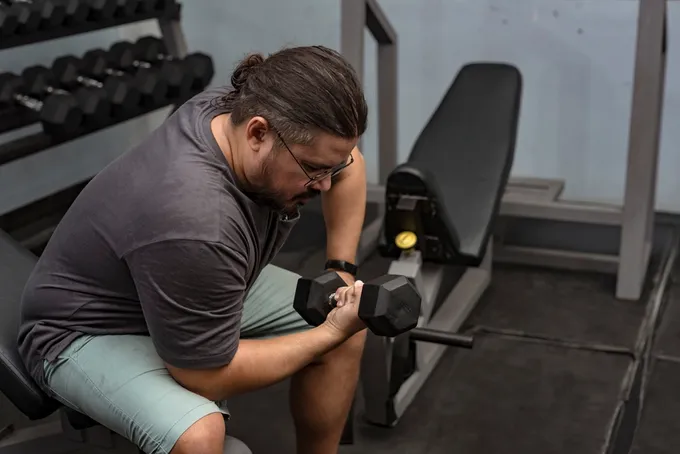Exercising with Stress Fractures in the Foot: Dos and Don'ts
Updated July 29, 2025

Did you know that stress fractures account for over 10% of all injuries in sports medicine? These tiny, painful cracks in the bones pose a unique challenge to maintaining an active lifestyle. For those bravely facing this hurdle, we've got your back.
Let's dive into understanding stress fractures and exploring how you can remain active without worsening your condition.
Understanding Stress Fractures
Stress fractures are micro-cracks in your bones, often resulting from repetitive force activities, such as jumping or long-distance running. They are most commonly found in the lower leg or foot, resulting in painful swelling that can make even routine tasks like walking a test of endurance.
But what exactly causes these fractures? It boils down to overuse, muscle tightness, and weakness. A sudden surge in activity duration or intensity also ups the risk of developing stress fractures.
» Learn about the possible causes of forefoot pain
Recovery Timeline and Precautions
Typically, a foot stress fracture will have you on a recovery path for around 6-8 weeks. During this period, you'll need to tread lightly to prevent further injury. But don't worry—staying active and nursing your fracture aren't mutually exclusive. Let's explore some safe exercises and those you're better off avoiding during recovery.
Vitamin D and Calcium: Key to Bone Health
Did you know that adequate Vitamin D and Calcium intake is essential for bone health? These nutrients help your bones to heal faster from stress fractures. Incorporating foods rich in Vitamin D (like fatty fish, fortified dairy products, and egg yolks) and Calcium (like dairy products, green leafy vegetables, and tofu) into your diet can aid recovery.
» Struggling with flat feet? Check out the best insoles for flat feet for ease and comfort
How to Exercise with a Stress Fracture?
Exercising with stress fractures requires caution. Aim for activities that sidestep exerting stress on your lower legs (especially repetitive impact), and consult your doctor before introducing any new exercise routine. Always prioritize comfort and safety. If you feel any discomfort or pain, it's time to hit the brakes.
Cycling: A Low-Impact Solution
Cycling, particularly stationary cycling, is a great way to maintain fitness when dealing with a foot stress fracture. This low-impact activity ensures you aren't further straining your foot. If you're experiencing severe pain, a walking boot can offer added support. Remember, start slow and gradually increase your intensity to ensure safety.
Swimming: Let Water Aid Your Recovery
Swimming and other water exercises are excellent low-impact choices for those with foot stress fractures. Performing your exercise routine in water alleviates weight from your lower legs while providing resistance, giving you a solid workout without worsening your injury. From swimming for cardiovascular fitness to water-based strength training, the pool can be your best friend during recovery.
Lifting Weights: Strengthening More Than Legs
While recovering from a stress fracture, seated weightlifting exercises can help keep you in shape and allow you to work your upper body muscles, all while sparing your affected lower leg.
This approach ensures that you continue to strengthen your body without risking further injury. Be careful to avoid exercises that could put unnecessary pressure on your lower leg. As with any exercise regimen, stop immediately if you feel discomfort or pain.
Activities to Avoid with a Stress Fracture
While recovering, aim to limit activities that increase the load on your lower leg. Walking and running are top culprits to avoid as they might hinder healing or even reopen a partially healed fracture. Crutches can be a practical solution to minimize weight-bearing during this time.
Did You Know?
Stress fractures often heal without any visible signs. The pain may decrease long before the fracture has fully healed. Just because the pain has diminished doesn't mean you can return to high-impact activities. Always follow your healthcare provider's advice.
Leveraging Orthotics for Prevention
Orthotics, like the ones offered by Upstep, can be your trusty sidekick in preventing stress fractures. How? They absorb shock and lessen the impact of repetitive force on your feet.
Upstep’s custom orthotics are designed to provide the support and cushioning your feet need. They prevent foot pronation, a known risk factor for medial stress syndrome, allowing you to push your limits without the fear of shin pain.
Your Route to Healthier Training
High-quality custom orthotics from Upstep are tailored to meet your unique needs. With their shock-absorbing capabilities, you can train longer, harder, and smarter. They are a valuable addition to anyone's arsenal, whether you're looking to prevent stress fractures or recover from them.
Don't let stress fractures keep you on the sidelines. Enhance your training, protect your feet, and step up your game with Upstep's custom orthotics. Take the first step towards a pain-free life—try Upstep's custom orthotics today!









